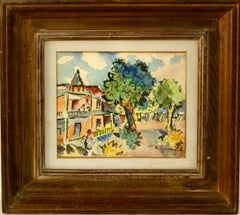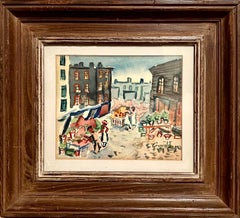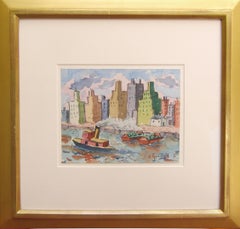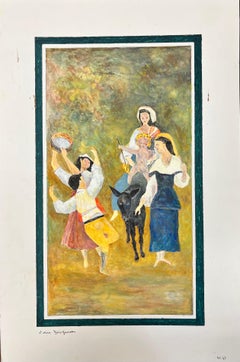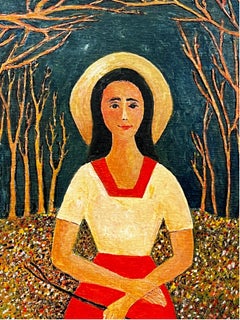Samuel Grunvald Paintings
to
3
Overall Width
to
Overall Height
to
3
3
2
3
3
3
1
6
781
717
705
691
1
3
Artist: Samuel Grunvald
1940's Americana WPA Modernist Watercolor Painting Catskill Mountains Bungalow
By Samuel Grunvald
Located in Surfside, FL
Bungalow (fauvist painting of New York scene) 1940's.
image is 10X 11.5 inches. Hand signed lower right
Country Scene
Samuel Grunvald was a Hungarian born American WPA artist known...
Category
1940s Modern Samuel Grunvald Paintings
Materials
Watercolor
1940's American WPA Modernist New York City Watercolor Painting Tenement Market
By Samuel Grunvald
Located in Surfside, FL
The Market, (fauvist painting of NYC scene) 1940's.
image is 10X 11.5 inches. Hand signed lower right
Lower East Side Tenements Pushcart Market
Samuel Grunvald was a Hungarian bor...
Category
1940s Modern Samuel Grunvald Paintings
Materials
Watercolor
Skyline and Tugboat, East River, New York City
By Samuel Grunvald
Located in New York, NY
Samuel Grunvald excelled at watercolors and was a native New Yorker who portrayed his city as such as he depicted its skyline, architecture and particular character with love and ent...
Category
1940s Samuel Grunvald Paintings
Materials
Paper, Watercolor
Related Items
1950's Modernist/ Cubist Painting - Figures Celebrating Life
By Bernard Labbe
Located in Cirencester, Gloucestershire
French Figures
by Bernard Labbe (French mid 20th century)
original gouache on card
size: 19.5 x 13 inches
condition: very good and ready to be enjoyed
...
Category
Mid-20th Century Modern Samuel Grunvald Paintings
Materials
Gouache
$514 Sale Price
30% Off
H 19.5 in W 13 in
1950's Modernist/ Cubist Painting - The Girl In The Forest
By Bernard Labbe
Located in Cirencester, Gloucestershire
Portrait
by Bernard Labbe (French mid 20th century)
original gouache on artist paper, unframed
size: 19.5 x 16.5 inches
condition: very good and ready to be enjoyed
provenance: the ...
Category
Mid-20th Century Modern Samuel Grunvald Paintings
Materials
Gouache
$467 Sale Price
30% Off
H 19.5 in W 16.5 in
1950's Big Modernist/ Cubist Painting - Figures Gathered
By Bernard Labbe
Located in Cirencester, Gloucestershire
French Landscape
by Bernard Labbe (French mid 20th century)
original gouache on paper mounted on card
size: 18.75 x 24 inches
condition: very good and ready to be enjoyed
provenance...
Category
Mid-20th Century Modern Samuel Grunvald Paintings
Materials
Gouache
$700 Sale Price
30% Off
H 18.75 in W 24 in
1950's Modernist/ Cubist Painting - Busy Figures In Forest
By Bernard Labbe
Located in Cirencester, Gloucestershire
French Landscape
by Bernard Labbe (French mid 20th century)
original gouache on paper stuck on card
size: 18 x 25 inches
condition: very good and ready t...
Category
Mid-20th Century Modern Samuel Grunvald Paintings
Materials
Gouache
$420 Sale Price
30% Off
H 18 in W 25 in
'Towards Le Scathe Cove'. Contemporary Landscape, Rural, Sea, Ocean, Beach Blue
By Sophia Milligan
Located in Penzance, GB
'Towards Le Scathe Cove'. Contemporary mixed media landscape painting, Cornwall
Original Artwork, Unframed
_________________
January morning, heavy swell and a strong southwester, rain imminent, sheltering beneath lichen furred granite outcrops.
A plein air painting from the series 'Holan ha Dor' (Meaning 'Salt and Earth in Cornish). West Cornwall is a harshly beautiful peninsula, jutting out into the wild tireless ocean, shaped and moulded by powerful salt laden Atlantic winds, and criss-crossed by ancient, tangled hedgerows. Drawn to the immediacy of moments, underpinned by enduring narratives, Sophia's fluid expressive paintings explores the flux and balance in the nature of all things: The freedom of the air and solidity of the soil; Of anchored stone and rhythmic water; Of human narratives written in the wild landscapes; In the sensual interplay of light and shadow. They capture an essence of the equilibrium between wild raw energy and serene stillness; chaos and harmony; and the enduring and the effervescent.
Mixed media on watercolour paper
Signed and inscribed
Unframed
23 x 30cm / 9 x 12 inches
__________________________
About The Artist
Sophia Milligan is a contemporary multidisciplinary artist, exploring discourses on permanence & evanescence; the eternal, cyclical absolutes of birth & death; motherhood & childhood; and ancient immutable connections. With resonating ripples of intuition and instinct Sophia illuminates the presence of the ordinary, creating moments of sublime present.
'Born among the wild cliffs and tempestuous seas of west Cornwall, I grew with the intimate details in the twisting lanes and the intense changing light throughout the turbulent seasons. I formed a primordial connection with a deep instinctual sense of being part of the natural narrative, and wherever in the world I may be, this connectivity underpins my practice. Like the wind sculpted hawthorns and sensual coves of weather worn granite, I have been shaped by the powerful energy entwined in this ancient raw environment.’
‘We are the stories of the journeys that came before. I weave into my work the tales of transitory circumstance; of struggle and survival; of forms and textures holding records of evolutionary millennia. I paint, I draw: with marks, mixtures, photography, words; the raw earth; the restless oceans; the whispered breeze. I work with time, and the immeasurable spaces of experience within, giving subtleties of existence a pause for contemplation. There is beauty in such poignant breaths. All moments are significant, every pebble of now forms the vast mountain of yesterday, and the great realm of tomorrow's possibilities'.
Sophia has a 1st class honours Bachelor of Arts Degree in Visual Arts and World History, and a Masters Degree in Contemporary Visual Arts. Her work is held in prestigious international private collections, and exhibitions of her interactive, immersive installation, photography and mixed media works include 'Tabula Rasa', London; 'Superlative', Plymouth; 'Transition', Newlyn; The Eden Project, Cornwall; The European Parliament, Brussels; Kew Gardens, London; and 'The Cameraless Film Festival', Chicago...
Category
2010s Contemporary Samuel Grunvald Paintings
Materials
Ink, Watercolor, Archival Paper, Crayon, Wax, Acrylic, Color Pencil
Sophia Milligan'Towards Le Scathe Cove'. Contemporary Landscape, Rural, Sea, Ocean, Beach Blue, 2022
$334 Sale Price
50% Off
H 9 in W 12 in
Italian Grand Tour Style Signed Landscape
Located in Roma, IT
Important watercolor painting representing a beautiful view of Rome with the Tiber, Castel Sant'Angelo and the dome of St. Peter's in the background.
A typical work in the vein of th...
Category
Late 19th Century Italian School Samuel Grunvald Paintings
Materials
Watercolor, Paper
1950's Big Modernist/ Cubist Painting - Parisian Apartment
By Bernard Labbe
Located in Cirencester, Gloucestershire
French Landscape
by Bernard Labbe (French mid 20th century)
original gouache on artist paper, unframed
size: 25.5 x 19.5 inches
condition: very good and ready to be enjoyed
provenan...
Category
Mid-20th Century Modern Samuel Grunvald Paintings
Materials
Gouache
$467 Sale Price
30% Off
H 25.5 in W 19.5 in
Glassblowers WPA American Scene Mid- 20th Century Modern Figurative Workers 1932
By Harry Gottlieb
Located in New York, NY
Glassblowers WPA American Scene Mid- 20th Century Modern Figurative Workers. Dated and signed "32 Harry Gottlieb" lower right. Sight: 13 1/8" H x 18 1/4" W.
Harry Gottlieb, painter, screenprinter, educator, and lithographer, was born in Bucharest, Rumania. He emigrated to America in 1907, and his family settled in Minneapolis. From 1915 to 1917, Gottlieb attended the Minneapolis Institute of Arts. After a short stint as an illustrator for the U.S. Navy, Gottlieb moved to New York City; he became a scenic and costume designer for Eugene O"Neill's Provincetown Theater Group. He also studied at the Philadelphia Academy of Fine Arts and the National Academy of Design.
He was one of America's first Social Realist painters, influenced by that Robert Henri-led movement in New York City where Gottlieb settled in 1918. He was also a pioneer in screen printing, which he learned while working for the WPA. He married Eugenie Gershoy, and the couple joined the artist colony at Woodstock, New York. He lectured widely on art education.
In 1923, Gottlieb settled in Woodstock, New York and in 1931, spent a a year abroad studying under a Guggenheim Fellowship.
In 1935, he joined the Federal Art Project...
Category
1930s American Modern Samuel Grunvald Paintings
Materials
Paper, Gouache
Harry GottliebGlassblowers WPA American Scene Mid- 20th Century Modern Figurative Workers 1932, 1932
$3,520 Sale Price
20% Off
H 21 in W 26 in D 2 in
View of the Ovo Castle in the Moonlight, a 19th century Neapolitan gouache
Located in PARIS, FR
Neapolitan gouaches appeared in the eighteenth century when tourism in the Naples area was developing: the discoveries of Herculaneum and Pompeii made this city a mandatory stop on the Grand Tour, the journey made by wealthy Europeans to complete their education.
Generally small in size for ease of transport and affordable in price, these gouaches were the ideal travel souvenir that these tourists of the early days were bringing back to capture the idyllic landscapes they had discovered during their journey and to share them with family and friends upon their return at home.
The Bay of Naples and the eruptions of Vesuvius are the favourite themes of these views. Here we have a view of the Ovo Castle, which was rebuilt on the island of Partenope, in the middle of the Bay of Naples and about a hundred metres from the shore by the Normans in the 12th century on antique ruins...
Category
Early 19th Century Romantic Samuel Grunvald Paintings
Materials
Gouache, Paper
$1,412
H 12.19 in W 14 in
Leaving the Factory- American Scene Watercolor Painting-WPA Painter
Located in Marco Island, FL
David Fredenthal captures the chaotic rush of men leaving their jobs at the factory. The setting is possibly the Rouge Factory, one of Henry Ford's most important and earliest fact...
Category
Early 20th Century American Realist Samuel Grunvald Paintings
Materials
Gouache, Archival Paper
$42,000
H 33 in W 43 in D 2 in
View of the surroundings of Saint-Cloud from Meudon near Paris in France
Located in BELEYMAS, FR
Antoine-Ignace MELLING
(1763 Karlsruhe - 1831 Paris)
View of the surroundings of Saint-Cloud from the terrace of Bellevue in Meudon
Watercolor and gouache
H. 62.5 cm; W. 93.5 cm
Sign...
Category
1810s French School Samuel Grunvald Paintings
Materials
Paper, Watercolor
$52,874
H 24.61 in Dm 36.82 in
Original Painting. New Yorker Mag Cover Proposal WPA Mid Century American Scene
By Antonio Petruccelli
Located in New York, NY
Original Painting. New Yorker Mag Cover Proposal WPA Mid Century American Scene
Antonio Petruccelli (1907 – 1994)
Perplexed Gentleman
New Yorker cover proposal, c. 1939
13 1/4 X 8 ...
Category
1930s American Modern Samuel Grunvald Paintings
Materials
Gouache, Board
Previously Available Items
1940's Americana WPA Modernist Watercolor Painting Catskill Mountains Bungalow
By Samuel Grunvald
Located in Surfside, FL
Bungalow (fauvist painting of New York scene) 1940's.
image is 10X 11.5 inches. Hand signed lower right
Country Scene
Samuel Grunvald was a Hungarian born American WPA artist known for abstract, landscape and seascape paintings.
Arrived in the USA from Hungary in 1921 and settled in New York City where he studied at the Art Students League. Grunvald worked for the Federal Art Project, taught at Colony House in NYC. Member: Art Guild, Watercolor Society, New York Watercolor Club. exhibited at Montross Gallery, NYC, World House Galleries, NYC, Leonard Hutton Gallery, NYC, Associated American Artists Gallery and the A.C.A. Gallery. Gunvald's work spanned many modern American movements from the WPA to Abstract Expressionist painting. He was a member of the American Watercolor Society and the Brooklyn Society of Artists. He exhibited with both of these organizations and at the Brooklyn Museum of Art. He was involved the the WPA being a Federal Arts Project artist. A number of prominent Jewish artists participated in this New Deal program among them Ben Shahn, Joseph Solman, William Gropper, Philip Guston Adolph Gottlieb, Mark Rothko, Milton Avery, Ben Shahn, the Soyers (Isaac, Moses, and Raphael), and many others
Grunwald exhibited alongside other popular artists such as Paul Klee, Jean Arp, Max Ernst and Charles Burchfield. He also taught and lectured on art and easel painting, Federal Art Project, NYC. His work is included in the collections of the Museum of Modern Art and The Jewish Museum, New York. Americana.
The Catskills became a major resort destination for Jewish New Yorkers in the mid-20th century. Borscht Belt is an informal term for the summer resorts of the Catskill Mountains in Sullivan and Ulster counties in upstate New York which were frequented by Ashkenazi Jews. At its peak of popularity, about 500 resorts operated in the region. Later changes in vacationing patterns have led most of those travelers elsewhere, although there are still bungalow communities and summer camps in the towns of Liberty, Bethel, Monticello and Fallsburg catering to Orthodox Jewish populations. Borscht Belt, The term, which derives from the name of a beet soup popular with people of Eastern European origin, can also refer to the Catskill region itself.
In August, 1969, the Catskills were the site of a music and art festival in the town of Bethel, which had originally been planned for Woodstock, New York. Thirty-three of the best-known musicians of the era appeared during a sometimes rainy weekend in front of nearly half a million concertgoers. The event, featuring liberal drug use and nudity, exemplified the counterculture of the 1960s and 1970s.
Select Exhibitions
A.C.A. Gallery
Associated American Artists Gallery, 1936-1955
American Watercolor Society, 1932-1942
New York Watercolor Club, 1935-1937
Humanist Art...
Category
1940s Modern Samuel Grunvald Paintings
Materials
Watercolor
1940's American WPA Modernist New York City Watercolor Painting Tenement Market
By Samuel Grunvald
Located in Surfside, FL
The Market, (fauvist painting of NYC scene) 1940's.
image is 10X 11.5 inches. Hand signed lower right
Lower East Side Tenements Pushcart Market
Samuel Grunvald was a Hungarian born American WPA artist known for abstract, landscape and seascape paintings.
Arrived in the USA from Hungary in 1921 and settled in New York City where he studied at the Art Students League. Grunvald worked for the Federal Art Project, taught at Colony House in NYC. Member: Art Guild, Watercolor Society, New York Watercolor Club. exhibited at Montross Gallery, NYC, World House Galleries, NYC, Leonard Hutton Gallery, NYC, Associated American Artists Gallery and the A.C.A. Gallery. Gunvald's work spanned many modern American movements from the WPA to Abstract Expressionist painting. He was a member of the American Watercolor Society and the Brooklyn Society of Artists. He exhibited with both of these organizations and at the Brooklyn Museum of Art. He was involved the the WPA being a Federal Arts Project artist. A number of prominent Jewish artists participated in this New Deal program among them Ben Shahn, Joseph Solman, William Gropper, Philip Guston Adolph Gottlieb, Mark Rothko, Milton Avery, Ben Shahn, the Soyers (Isaac, Moses, and Raphael), and many others
Grunwald exhibited alongside other popular artists such as Paul Klee, Jean Arp, Max Ernst and Charles Burchfield. He also taught and lectured on art and easel painting, Federal Art Project, NYC. His work is included in the collections of the Museum of Modern Art and The Jewish Museum, New York. Americana.
Select Exhibitions
A.C.A. Gallery
Associated American Artists Gallery, 1936-1955
American Watercolor Society, 1932-1942
New York Watercolor Club, 1935-1937
Humanist Art...
Category
1940s Modern Samuel Grunvald Paintings
Materials
Watercolor
1940's American WPA Modernist New York City Watercolor Painting Subway Riders
By Samuel Grunvald
Located in Surfside, FL
The Subway, (fauvist painting of NYC scene) 1940's.
image is 8 X 9.5 inches. Hand signed lower right
Provenance: Greenwich Gallery (Greenwich CT)
Samuel Grunvald was a Hungarian b...
Category
1940s Modern Samuel Grunvald Paintings
Materials
Watercolor
Samuel Grunvald paintings for sale on 1stDibs.
Find a wide variety of authentic Samuel Grunvald paintings available for sale on 1stDibs. You can also browse by medium to find art by Samuel Grunvald in paint, watercolor, paper and more. Much of the original work by this artist or collective was created during the 1940s and is mostly associated with the modern style. Not every interior allows for large Samuel Grunvald paintings, so small editions measuring 10 inches across are available. Customers who are interested in this artist might also find the work of William Harnden, Alfred Wands, and Hal Frater. Samuel Grunvald paintings prices can differ depending upon medium, time period and other attributes. On 1stDibs, the price for these items starts at $2,500 and tops out at $3,800, while the average work can sell for $2,500.
